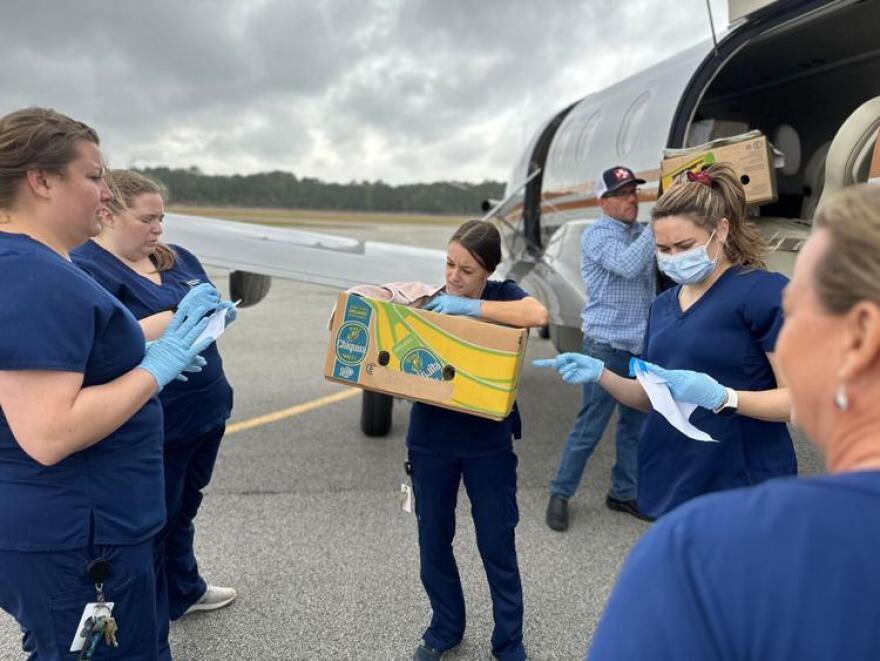CHARLESTON, S.C. - The South Carolina Aquarium offers more than a window to life under the sea, it also serves as a triage for injured and endangered sea turtles.
Beneath the exhibits lies a protected world of whirling pools, humming pumps and a myriad of machines. Senior biologist Cait Crosby makes the rounds, checking in on her beak-nosed, flippered, and sometimes splashing patients.
“I personally spent several days worrying about this animal,” says Crosby as she peers into the tank of a Kemps’ ridley turtle named, “Taurus”, one of more than 100 cold stunned sea turtles rescued from the Cape Cod coast.
Crosby says cold stunning happens when ocean temperatures suddenly drop, causing sea turtles to suffer from hypothermia.

The South Carolina Aquarium Sea Turtle Care Center received 18 Kemps’ ridley and green sea turtles by plane in November. Some were in critical condition with body temperatures of 40 to 50 degrees. They had low or irregular heart rates, as well as raspy breathing.
“They can be susceptible to pneumonia, which is a lung infection,” says Crosby. “They can develop osteomyelitis, which is a bone infection we typically see in the joints of, like, the elbow or the shoulder.”
Then, just before Christmas, three more cold stunned green sea turtles were brought in from the South Carolina coast just before Christmas.
Just a couple of pools over from “Taurus” is a green sea turtle named, “Karena,” who barely lifts its head to come up for a breath.
The manager of the Sea Turtle Care Center, Melissa Ranly, remembers when Karena was pulled from the waters off Huntington Beach State Park with barely a pulse and suffering from kidney failure.
“You can actually see some of the areas around her beak where there are wounds that go all the way down to the bone,” says Ranly.
But slowly, Karena is coming around too. She pokes her head up ever so cautiously from her shallow pool to take a breath. Several fellow patients from Cape Cod have since been released into warmer waters off the Florida coast.
So, what is causing these sea turtles to get stuck and sick in frigid waters? Their caretakers say climate change.
Crosby explains warmer waters in Florida are creating food shortages, so sea turtles are heading farther north to feed.
“And they’re staying up in those spaces longer than they normally would because that water temperature is staying warmer longer than it should, says Crosby.

Then, when cold weather suddenly strikes, Ranly says, sea turtles find themselves in dire situations.
“If the water temperature drops too quickly, their bodies can’t respond,” says Ranly. “They just become hypothermic and almost catatonic floating to the surface.”
But sea turtles don’t just live in the ocean, they also rely on land to lay their eggs.
Ranly says rising sea levels, king tides and more destructive storms are not only washing away turtle nesting grounds, but scorching temperatures are taking a toll on the sand.
“When sand temperatures get warmer, that impacts the gender of the hatchlings,” says Ranly.
Scientists believe warmer sand produces more females. And, depending on the species, it can take ten to 50 years to determine the sex of a sea turtle. So even though South Carolina saw a productive nesting season in 2022, nearly 8,000, we may not know for decades if too many females were born.
Not enough males could mean fewer nests. That could be not only detrimental to the future of the endangered species, but our safety as well.
“Sea turtles, when they nest, they actually play a really important role in maintaining that dune system because the nutrition that comes from the eggshells,” says Crosby.
The shells, she says, feed the dunes grass and dunes are the first defense against high tides and storms.
Sea turtles are so resilient, they’ve survived for millions of years and are considered a key stone species.
“Which means they are an indicator for how well that environment is doing,” says Crosby. “Their presence within an ecosystem sustains it. They need to be there.”
And we need them to be there, says Crosby. Sea turtles are a window into our world and the health of the environment.



